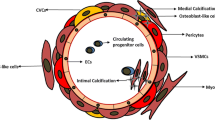Summary
Osteoclast-like cells are known to inhibit arterial calcification. Receptor activator of NF-κB ligand (RANKL) is likely to act as an inducer of osteoclast-like cell differentiation. However, several studies have shown that RANKL promotes arterial calcification rather than inhibiting arterial calcification. The present study was conducted in order to investigate and elucidate this paradox. Firstly, RANKL was added into the media, and the monocyte precursor cells were cultured. Morphological observation and Tartrate resistant acid phosphatase (TRAP) staining were used to assess whether RANKL could induce the monocyte precursor cells to differentiate into osteoclast-like cells. During arterial calcification, in vivo and in vitro expression of RANKL and its inhibitor, osteoprotegerin (OPG), was detected by real-time PCR. The extent of osteoclast-like cell differentiation was also assessed. It was found RANKL could induce osteoclast-like cell differentiation. There was no in vivo or in vitro expression of osteoclast-like cells in the early stage of calcification. At that time, the ratio of RANKL to OPG was very low. In the late stage of calcification, a small amount of osteoclast-like cell expression coincided with a relatively high ratio of RANKL to OPG. According to the results, the ratio of RANKL to OPG was very low during most of the arterial calcification period. This made it possible for OPG to completely inhibit RANKL-induced osteoclast-like cell differentiation. This likely explains why RANKL had the ability to induce osteoclast-like cell differentiation but acted as a promoter of calcification instead.
Similar content being viewed by others
References
Rennenberg RJ, Schurgers LJ, Kroon AA, et al. Arterial calcifications. J Cell Mol Med, 2010,14(9):2203–2210
Neven E, De Schutter TM, De Broe ME, et al. Cell biological and physicochemical aspects of arterial calcification. Kidney Int, 2011,79(11):1166–1177
Dellegrottaglie S, Sanz J, Rajagopalan S. Molecular determinants of vascular calcification: a bench to bedside view. Curr Mol Med, 2006,6(5):515–524
Tyson KL, Reynolds JL, McNair R, et al. Osteo/chondrocytic transcription factors and their target genes exhibit distinct patterns of expression in human arterial calcification. Arterioscler Thromb Vasc Biol, 2003,23(3):489–494
Shao JS, Cai J, Towler DA. Molecular mechanisms of vascular calcification: lessons learned from the aorta. Arterioscler Thromb Vasc Biol, 2006,26(7),1423–1430
Massy ZA, Mentaverri R, Mozar A, et al. The pathophysiology of vascular calcification: are osteoclast-like cells the missing link? Diabetes Metab, 2008,34 Suppl 1:S16–20
Simpson CL, Lindley S, Eisenberg C, et al. Toward cell therapy for vascular calcification: osteoclast-mediated demineralization of calcified elastin. Cardiovasc Pathol, 2007,16(1):29–37
Trouvin AP, Goëb V. Receptor activator of nuclear factor- κB ligand and osteoprotegerin: maintaining the balance to prevent bone loss. Clin Interv Aging, 2010,19(5):345–354
Xie H, Xie PL, Wu XP, et al. Omentin-1 attenuates arterial calcification and bone loss in osteoprotegerin-deficient mice by inhibition of RANKL expression. Cardiovasc Res, 2011,92(2):296–306
Helas S, Goettsch C, Schoppet M, et al. Inhibition of receptor activator of NF-kappaB ligand by denosumab attenuates vascular calcium deposition in mice. Am J Pathol, 2009,175(2):473–478
Roodman GD, Ibbotson KJ, Mac Donald BR, et al. 1, 25-Dihydroxyvitamin D3 causes formation of multinucleated cells with several osteoclast characteristics in cultures of primate marrow. Proc Natl Acad Sci USA, 1985,82(23):8213–8217
Castellot JJJ, Favreau LV, Karnovsky MJ, et al. Inhibition of vascular smooth muscle cell growth by endothelial cell-derived heparin. Possible role of a platelet endoglycosidase. J Biol Chem, 1982,257(19):11 256–11 260
Goto H, Osaki M, Fukushima T, et al. Human bone marrow adipocytes support dexamethasone-induced osteoclast differentiation and function through RANKL expression. Biomed Res, 2011,32(1):37–44
Liu C, Wan J, Yang Q, et al. Effects of atorvastatin on warfarin-induced aortic medial calcification and systolic blood pressure in rats. J Huazhong Univ Sci Technolog Med Sci, 2008,28(5):535–538
Valdivielso JM. Vascular calcification: types and mechanisms. Nefrologia, 2011,31(2):142–147
Olesen P, Nguyen K, Wogensen L, et al. Calcification of human vascular smooth muscle cells: associations with osteoprotegerin expression and acceleration by high-dose insulin. Am J Physiol Heart Circ Physiol, 2007,292(2): H1058–H1064
Min H, Morony S, Sarosi I, et al. Osteoprotegerin reverses osteoporosis by inhibiting endosteal osteoclasts and prevents vascular calcification by blocking a process resembling osteoclastogenesis. J Exp Med, 2000,192(4):463–474
Osako MK, Nakagami H, Koibuchi N, et al. Estrogen inhibits vascular calcification via vascular RANKL system: common mechanism of osteoporosis and vascular calcification. Circ Res, 2010,107(4):466–475
Panizo S, Cardus A, Encinas M, et al. RANKL increases vascular smooth muscle cell calcification through a RANK-BMP4-dependent pathway. Circ Res, 2009,104(9):1041–1048
Author information
Authors and Affiliations
Corresponding authors
Additional information
This project was supported by the Hubei Province Health and Family Planning Scientific Research Foundation of China (No. WJ2015MB141).
Rights and permissions
About this article
Cite this article
Nie, B., Zhou, Sq., Fang, X. et al. The function and meaning of receptor activator of NF-κB ligand in arterial calcification. J. Huazhong Univ. Sci. Technol. [Med. Sci.] 35, 666–671 (2015). https://doi.org/10.1007/s11596-015-1487-1
Received:
Revised:
Published:
Issue Date:
DOI: https://doi.org/10.1007/s11596-015-1487-1




